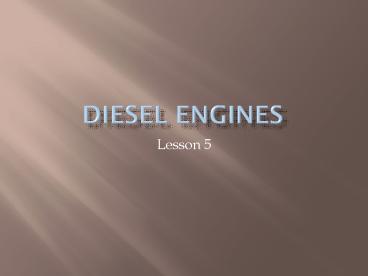DIESEL ENGINES PowerPoint PPT Presentation
1 / 28
Title: DIESEL ENGINES
1
DIESEL ENGINES
- Lesson 5
2
Introduction
- Rudolf Diesel-1892-high-compression,
self-ignition engine (intended to burn powered
coal) - Herbert Akroyd Stuart-1888-oil fuel was ignited
by compressing the mixture of oilair in contact
with a hot wall in the combustion chamber - the pressure was permanently increased ? hot
surfaces were not needed any more for the ignition
3
Diesel nowadays
- main or auxiliary propelling machinery
- OPERATING CYCLE
- two-stroke cycle
- four-stroke cycle
- CYCLE a series of steps following each other
- STROKE a single up or down movement
4
Piston Action
- single acting engines
- double- acting engines
- opposed piston engines
- Single acting engine one end of the cylinder to
develop power - Double-acting engine both ends of the cylinder
/ both piston faces - - complicated construction
- - low speed units
- - pistons shorter than in single acting engine
5
Cylinder arrangement
- In-line cylinder arrangement
- V arrangement of cylinders
- Flat arrangement of cylinders
- Radial arrangement of cylinders
6
In-line cylinder arrangement
7
V arrangement of cylinders
8
Flat arrangement of cylinders
9
Radial arrangement of cylinders
10
Engine Speed
- Low speed gt 200 rev/min
- Medium speed 200 600 rev/min
- High speed lt 600 rev/min
11
Piston connection
- Trunk piston engine (piston directly connected to
the rod) - Crosshead type engine (piston indirectly
connected to the rod piston rod / crosshead)
12
Trunk-piston engine
13
Cross-head type engine
14
Engine Drive
- Direct drive direct coupled engines (coupled
directly to the propeller shafting) - Geared engines indirect drive (coupled to a
reduction gearing)
15
Engine Rotation
- Direct reversible engine
- (clockwise anticlockwise rotation)
- Non-reversible engine
- (unidirectional engines)
16
The four-stroke cycle
- 1. INDUCTION crankshaft rotates clockwise and
the piston moves down the cylinder, inlet valve
is open and a fresh charge of air is drawn into
the cylinder.
17
The four-stroke cycle
- 2. COMPRESSION inlet valve has closed and the
charge of air is compressed by the piston as it
moves up the cylinder. Because energy is being
transferred into the air, its pressure and
temperature increase. By the time the piston is
approaching the TDC the pressure is over 100 bar
and the temperature over 500.
18
The four-stroke cycle
- 3. POWER Just before TDC fuel is injected into
the cylinder by the fuel injector. The fuel is
"atomised" into tiny droplets. Because they are
very small these droplets heat up very quickly
and start to burn as the piston passes over TDC.
19
The four-stroke cycle
- 4. EXHAUST As the piston approaches the BDC, the
exhaust valve starts to open. As the piston now
moves up the cylinder, the hot gases are expelled
from the cylinder. As the Piston approaches TDC
again the inlet valve starts to open and the
cycle is repeated.
20
The two-stroke cycle
- 1. The crankshaft revolves clockwise and the
piston moves up the cylinder, compressing the - charge of air. Because energy is being
transferred into the air, its pressure and
temperature increase. By the time the piston is
approaching the TDC the pressure is - over 100 bar and the temperature
- over 500C.
21
The two-stroke cycle
- 2. Just before TDC fuel is injected into the
cylinder by the fuel injector. The fuel is
"atomised" into tiny droplets. Because they are
very small these droplets heat up very quickly
and start to burn as the piston passes over TDC.
22
The two-stroke cycle
- The expanding gas from the fuel burning in the
oxygen forces the piston down the cylinder,
turning the crankshaft. It is during this stroke
that work energy is being put into the engine
during the upward stroke of the piston, the
engine is having to do the work.
23
The two-stroke cycle
- 3. As the piston moves down the cylinder, the
- useful energy from the burning fuel is expended.
- At about 110 after TDC the exhaust valve opens
- and the hot exhaust gases begin to leave the
cylinder.
24
The two-stroke cycle
- 4. At about 140º after TDC the piston uncovers a
- set of ports known as scavenge ports. Pressurised
- air enters the cylinder via these ports and
pushes - the remaining exhaust gas from the cylinder in a
- process known as "scavenging".
25
The two-stroke cycle
- The piston now goes past Bottom Dead Centre
- and starts moving up the cylinder, closing off
the - scavenge ports. The exhaust valve then closes and
- compression begins.
26
Timing diagram Four-stroke cycle
- The four-stroke cycle can be illustrated on a
timing diagram.
27
Timing diagram Two-stroke cycle
- The two-stroke cycle can be illustrated on a
timing diagram.
28
- http//www.youtube.com/watch?vx9yS2xdPJSUfeature
related - http//www.youtube.com/watch?vHQk1u_kvQSA
- http//www.animatedengines.com/
- http//www.dieselduck.net/machine/0120prime20mov
ers/diesel_engine/diesel_engine.02.htm - http//www.dieselduck.net/machine/0120prime20mov
ers/diesel_engine/diesel_engine.01.htm

